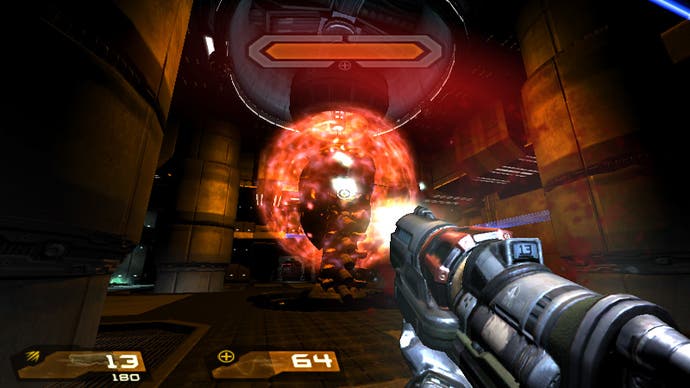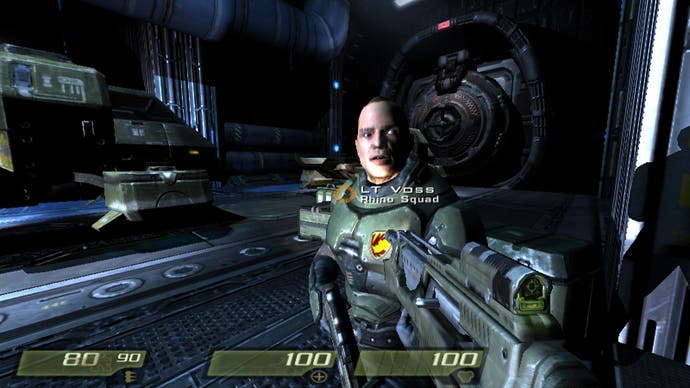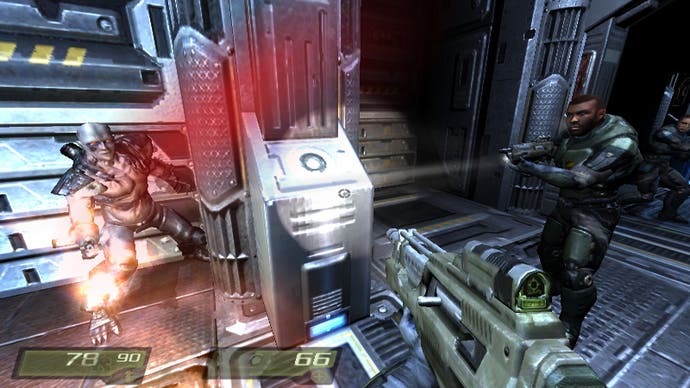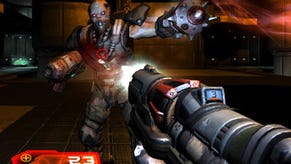Quake 4
Earth shattering?
Alien menaces never die, they just return in time to show off new gaming technology. That's definitely the case with Quake 4, with Earth's great foe, The Strogg, undeterred by the loss of their leader, the Makron. Far from being thrown into disarray, the cybernetic warriors regroup and rebuild a new, more powerful Makron. Sigh. Best take that one out as well then, eh?
Alternatively, the opening paragraph could have just as easily have gone like this:
Old franchises never die, they just return in time to show off new gaming technology. That's definitely the case with Quake 4, with Valve's great foe, id, undeterred by being too busy working on other stuff to get around to making another game in the Quake series. Far from being thrown into disarray, the Carmack, Willits and co regroup and build the new, more powerful Doom III game engine and commission long-term cohorts Raven to churn out a game that picks up where Quake II left off. Sigh. Best dust off the Alienware mouse and stick it to The Strogg one more time, eh?
Whichever opening salvo you prefer, the general message appears to be one of 'don't be surprised'. Because everything about Quake 4 is in its right place. No alarms, no surprises. But so much so that most of the veteran shooters among us will be rueing Raven's overly formulaic approach to something that we were all hoping would amaze us. It doesn't. In summary, Quake 4 is a textbook example of 'how to make a highly competent first-person shooter using someone else's new engine'.
Tick, tick, tick
It ticks all the right boxes: decent, chatty buddy AI, a semblance of a storyline, 'thrilling' on-rails sections, a fine selection of (upgradeable) weapons, an interesting plot twist, some 'intense action', mech combat, tank combat and all wrapped up in the most powerful graphics engine the world has ever seen. How could it fail?
Well, it doesn't exactly fail at anything it does, except perhaps do the things that you'd expect a next generation shooter to do, to do something, anything, that a bunch of other games haven't done to death already. This is the crucial point, because in a genre as saturated as the FPS there needs to be some element of surprise, some sense of the unknown to drag you through, or else you end up feeling like you could be playing any number of other shooters. It needs its own stamp, its own personality, and that's most crucially where Quake 4 lacks. But enough of that for the moment; let's start at the beginning.
You're thrown into the fray as Rhino squad's new recruit Matthew Kane, and the game kicks off in typically macho big-space-marines-with-even-bigger-guns-and-we're gonna-kick-ass sci-fi style with your ship heading for a final assault on the pesky Strogg. But things don't get off to the best of starts when Rhino squad are shot out of the sky and most of the team perish in the ensuing crash. With typically spectacular Doom III-powered aplomb, the scene's set. The dust, the noise, the confusion. Am I alive? Where am I? "Get over here marine!"
Lazy line painter Jane

One thing is clear: brown is back, and it's browner than ever, and as we quickly descend through the linear path of rubble into the linear bowels of the linear Strogg base, Quake 4 starts as it means to go on: by ordering you around like the underling you are, in formulaic, linear fashion. With the game kicking-off on Kane's first day of frontline duty, you're forever being told what to do, where to go, and to be quick about it. No-one really expects this freshman to see out the day, but how can the Strogg menace stand in the way of one man and his trusty quick-save key?
From the very beginning, right to the end of the game, Raven is more than happy to design a pretty, linear and by-the-numbers shooter that has you plodding hither and thither down dark and eery metallic (brown) corridors, replete with flashing consoles on a series of 'flick this switch' quests for the next ten or so hours. Of course, along the way you're expected to duke it out with thousands of lurking Strogg, but that's all in the line of duty.
To break up the action a little, occasionally you'll hop aboard a giant Walker mech and stomp around for a bit causing maximum destruction (but never actually die because you've got a rechargeable shied), or glide around in a SMC Hovertank shooting equally gigantic (and admittedly spectacular) targets (and rarely die for the same reasons), or engage in some on-rails shooting against a band of relentless pursuers (and never die, because, well, it's a piece of piss). Now and then there's even the odd visually magnificent boss section to get the pulse racing (where you probably won't die). And a gigantic great plot twist (that id completely ruined for us back at E3 - thanks guys) to get excited about, only to realise it doesn't change anything. There's no doubt about it: Raven tries its best to throw in the right ingredients, but any vaguely experienced FPS player can tell it's suspiciously under-cooked. Numb yourself to the sense of familiarity, blur your eyes and convince yourself you haven't seen it all before and better and you could quite easily convince yourself that this was the best shooter you'd played since Half-Life 2. But this, of course, would be a dirty, filthy lie. It's a world away from that.
Eye Eye, cap'n

But break it down to its parts, and things don't sound nearly as negative. On a technical level, for one thing, it's incredible at times. Outstanding. Hook it up to a big widescreen monitor (preferably a plasma), and it's a tour-de-force action spectacular where every corner of every level is (often literally) dripping with such a stupefying amount of incidental detail you could spend ages just gawping at walls just to take in the majesty of it all.
Cunningly, Raven has even included a widescreen mode - making the effect even more cinematic if you've got the kit. Curiously no widescreen resolutions are supported, but it doesn't matter at all, so even playing at 800x600 on a 1360x768 screen looks breathtaking, allowing us to enjoy the full spectacle without having to endure too many performance hits on our 6800GT-powered 3.2GHz system. There are times when it really does look like the Hollywood blockbuster of videogames, but we're talking Independence Day crowd-pleasing cheese here, as opposed to, say, the dark malevolence of Aliens.
As much as we love the intensely beautiful texture and lighting effects, and admire the almost unbelievably-detailed and wondrously animated character models, the spectre of Doom III hangs heavy over the whole thing. The environments still rely on dark shadowy corners, and are rigidly, frustratingly non-interactive, with even your most overwhelmingly powerful weaponry barely scratching the surface. And enemy corpses still disappear, albeit this time in a green frazzle. And what happened to using clever physics to enhance the first-person shooter experience? Aside from being able to knock over a few barrels, that's literally the extent of Raven's ambitions here.
The shot remains the same

Weapons-wise, all the standards are present and (somewhat predictably) correct, and, yes, you can still carry all ten of them, even though some of them look as big as you do when you're wielding them. The initial Blaster gun wins the award for the least-used game weapon of all-time, but from the Machine Gun onwards, things rapidly improve with the usual array of old favourites (Lightning gun, Nail gun, Grenade launcher, Rocket launcher, and the BFG-esque Dark Matter gun etc, etc) making an appearance at gradual intervals throughout the game.
Amazingly, all bar the initial Blaster come in useful at some point or other, largely thanks to Raven's decision to allow technicians to apply upgrades to them as you go along. Nice touch. By the end, you'll be using pretty much every weapon in different tactical circumstances - Raven gets things spot-on in terms of giving you an array of long, short and medium range weapons that all get their fair-share of use during the campaign. And as a concession to the deluge of complaints about Doom III's torch/gun debate, the first two weapons now come with a mounted light - making it necessary to occasionally switch back to the machine gun when you're alone in the dark.
Though the weapons are well-balanced in terms of their effectiveness and usefulness, they're possibly a little too powerful for their own good, allowing you to charge into most situations suicidally and yet come out on top. The proliferation of accompanying buddy AI team-mates makes things easier to start with - and not just in terms of their extra firepower. Quake 4's team-mates even help top up health and armour, making it practically impossible to die in the first half of the game. And if that wasn't enough help, the dizzying amount of health and armour pick-ups makes much of the game a procession.
F5/F9 to infinity

The latter half of the game is much more of a lonely experience, meaning you'll begin to studiously rely on the F5 key in order to make consistent progress. A word of warning, though: try to resist the temptation to play the game on the first two difficulty settings; the first is just insultingly easy, while the second is just plain, old fashioned easy. We wished developers could just pitch Easy/Normal/Hard and leave it at that, instead of muddying the waters with four or more levels of difficulty. It's too easy to assume the second rung up is 'normal', when it's evidently not.
Even taking all of that into account, it's the AI that's ultimately to blame for the game's inability to challenge and involve. Quake 4 doesn't really do enough to make the core of the game all that exciting or different. This might sound like an insult, but essentially, the firefights feel more or less the same as Doom III, just without the old-school respawning out of a gap in the wall nonsense. They're largely tight encounters, four-on-one shootouts where they all rush at you suicidally, and it's a case of the bravest one wins. There's no Halo-esque ducking and diving, no running around cover points and playing hide and seek, just plenty of wham, blam, but no 'thank you ma'am'. After a while you realise it's neither especially challenging or that exciting. Even the boss encounters are unbelievably easy - some going down on our first attempt by merely unloading our fully stocked big guns and circle strafing. Compare this to, say, Metroid Prime 2's innovative and infinitely challenging bosses and weep.
Perhaps if the game's story was a real gripping sci-fi yarn of epic intrigue you could forgive the game's tendency to follow the FPS rules to the letter. But it isn't. Apart from the game's one moment of intrigue where it seems destined to follow a Doom-III's-journey-into-Hell-style sea change (but then doesn't) it's so deeply uninvolving you won't believe your eyes.
A pressing matter

All you're literally doing throughout the entire game - and this won't come as a spoiler - is charging after the next switch and taking down the next cluster of dim-witted Strogg. Powering down the next generator, turning off the security, meeting so-and-so, escorting so-and-so to such-and-such. And then there are the 'characters', which we use in the loosest sense of the word; a bunch of generic droids so devoid of personality, witty lines or any point to their existence at all that the fact that you can't gun them down yourself is the central low point of the game. At least their lip-synching is spot-on, eh? But what, exactly, is the point of constructing a story-driven game and then giving players the most tediously uninvolving tasks there have ever been? Aren't we beyond that now? Is this not 2005? The start of the next generation? At least Doom III had the little emails and audio logs to deliver something of a back-story. Quake 4's setting is an empty, soulless base, with radio chatter that (more often than not) gets completely buried in the audio mix. We know nothing of The Strogg's back-story, nothing of its prime movers and their plans. It's all just as simple as Earth against the aliens. KILL THEM ALL! WOOOOAAAARGH! HURRY UP KANE!
And then there's the multiplayer. The oh-my-god-is-that-it? multiplayer. The oh-my-god-I've-woken-up-from-a-six-year-Cryogenic-stasis-only-to-discover-it's-still-1999 type multiplayer. Actually, if the year was still 1999, the 16-player (only 16? 'Fraid so) thrills on offer would be considered very special indeed. Offering up standard Deathmatch, Team Deathmatch, Tournament (one-on-one), Capture the Flag and Team Capture the Flag, you can tell right there and then that daring innovation and effort was off the menu.
The fact that it's all good, old-fashioned fragging fun is maybe the point (particularly Deathmatch, as it happens), but it's hardly going to reinvigorate the passion for shooting other people in the head that 40 other games have managed during the six years that have elapsed since Quake III Arena showed up. Yes, you can play some of the old maps that you knew and loved in this glorious new engine, but the novelty nostalgia value will probably wear off sooner than you think. Complete with Q3 jump pads and that commentator; it's essentially more of the same old same old, which for some of you may be good enough, but not for us. Bah. Back to Battlefield 2, then. Maybe Quake Wars will get it right?
Rumble
That Quake 4 has arrived with such a muted fanfare is maybe telling. We all predicted in one of our more glib moments of cynicism that it would essentially be a brown Doom III, and that's not a million miles away from the truth. But you know what? Unlike a lot of people, I really dug Doom III - particularly the latter third that few people got to see - but Quake 4 feels like an uninspired, by-the-numbers sci-fi B-movie of a game with high production values. It's 'fun', for the nine, ten hours it lasts, but only in the same brainless sense that allows us to enjoy dumb popcorn action movies. It's only when you sit back and run through what's there you actually realise that there's not a lot of substance to Quake 4, beyond being very pretty indeed. We were hoping for rather more than a 'competent', 'fun' shooter out of Raven. Those words just sound insulting when you sit them next to the words 'Quake' and '4', and perhaps that sums up just why we think it only deserves a 7, and a low one at that. Shame.





